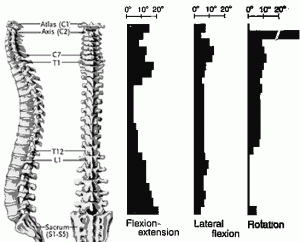 In the asana yoga practice forward bends quiet the nervous system, backbends energize the nervous system, and twists harmonize the nervous system bringing it back to center. This makes twists a very important part of the energy practice of yoga and very useful in modulating the energy that asanas can build. But twists are also a constant part of daily life and we rarely bring the same consciousness to everyday tasks that we do to a yoga class.
In the asana yoga practice forward bends quiet the nervous system, backbends energize the nervous system, and twists harmonize the nervous system bringing it back to center. This makes twists a very important part of the energy practice of yoga and very useful in modulating the energy that asanas can build. But twists are also a constant part of daily life and we rarely bring the same consciousness to everyday tasks that we do to a yoga class.
How much do you think the spine actually twists when we do one of the rotated poses in yoga or turn in our seat to look behind us as we back up a car? There is an illusory sense of how much movement actually takes place when we move the body. Very often in class I will raise my voice to implore people to go deeper but the extent of that “deeper” is millimeters not centimeters.
One of the earliest instructions I received about twisting still comes out of my mouth each and every twist that I teach. The spine must extend before it rotates. This extension is again recorded in millimeters, it is a tiny movement but it can open up a wide range of motion.
The ability to actually rotate spinal column increases as we move up the chain of vertebrae. The sacrum and is solidly wedged between the hip bones and though they can move up and down there is no twist available to this part of the spine. The coccyx doesn’t move much in relation to the rest of the spine but I very specifically begin my twists from the pelvic floor. Even though the sacrum and coccyx aren’t twisting the upward lift of energy from the pelvic floor (mula bandha) facilitates the extension and rotation of the spine.
The lumbar vertebrae have very little rotational capabilities as well. They are the largest vertebrae in the spine and their main job is to bear and transfer the weight of the head and upper spine to the legs. This supreme responsibility is difficult enough to accomplish without adding rotational stresses as well.
The thoracic spine has more rotational ability than the lumbar but it is still relatively limited in this direction. It is even more limited when it comes to backward bending. The thoracic, as opposed to both the lumbar and cervical, has no ability to bend backwards (the spinous process of the thoracic vertebrae make sure of that). The thoracic vertebrae are also smaller than the lumbar vertebrae as the column narrows as it rises.
The greatest range of motion in the spine lies in the smaller cervical vertebrae of the neck. These seven vertebrae are made for twisting having less bony restriction than the bones of the lower spine. The top two vertebrae, the atlas and the axis are particularly mobile. But this is a dangerous reality.
Twists need to start from the very base of the spine using core tone in the pelvic floor and abdomen to support the extension of the spine and rotation that begins well below the throat. The extreme mobility of the neck allows a great many people to think they are twisting their spine when they are really only twisting their neck.
Movement of the head and neck should start in the core and move through the hyoid bone before reaching the crown of the head. But there are many factors involved in what might limit an individual’s twisting. The ability to twist is most often limited by a lack of core tone to support the extension of the spine and tight inflexible muscles that surround the spine. A spine might be willing to twist but if the rhomboids and pectoral muscle of the upper chest are tight where is the upper body going to go? The same goes for the internal and external obliques, and the IT band in the lower trunk and legs. All of these muscles need to be supple for the trunk to twist successfully.
Where I teach people to think about the way they twist in yoga, I wouldn’t expect everyone to go about their day engaging and lengthening before every twist that we do in daily life. Counting the number of twists that I do in the course of a day would be an interesting project (I just started wearing a pedometer which is revelatory). This is where good resting tone in your muscles comes into play. If your muscles have natural tone you don’t need to engage them to complete an action like twisting.
But if you don’t have that natural tone the spine and its facet joints will suffer with every rotation.
***
